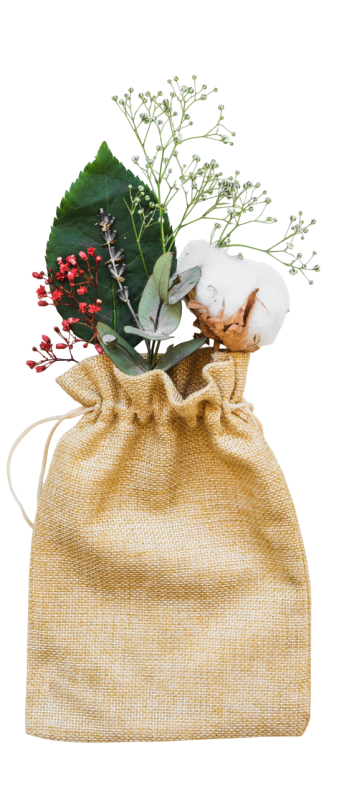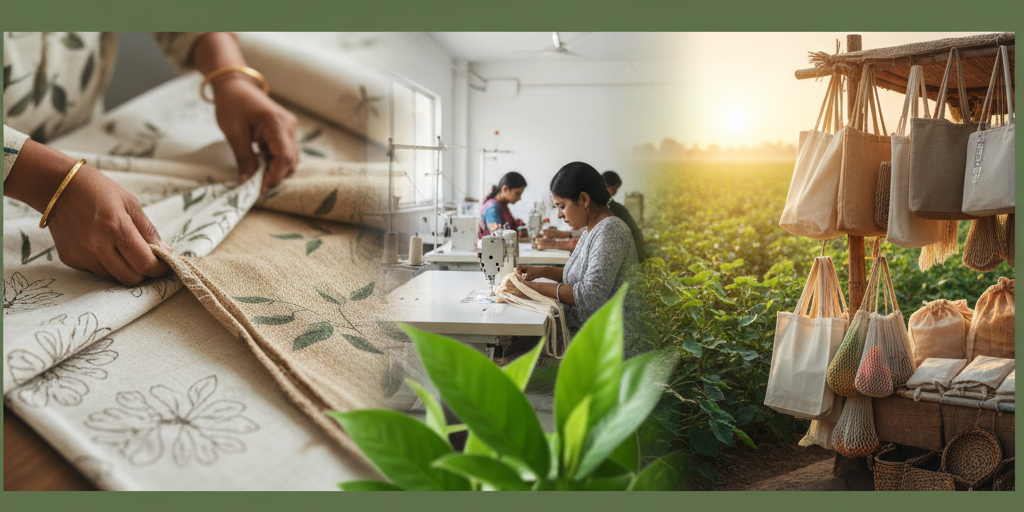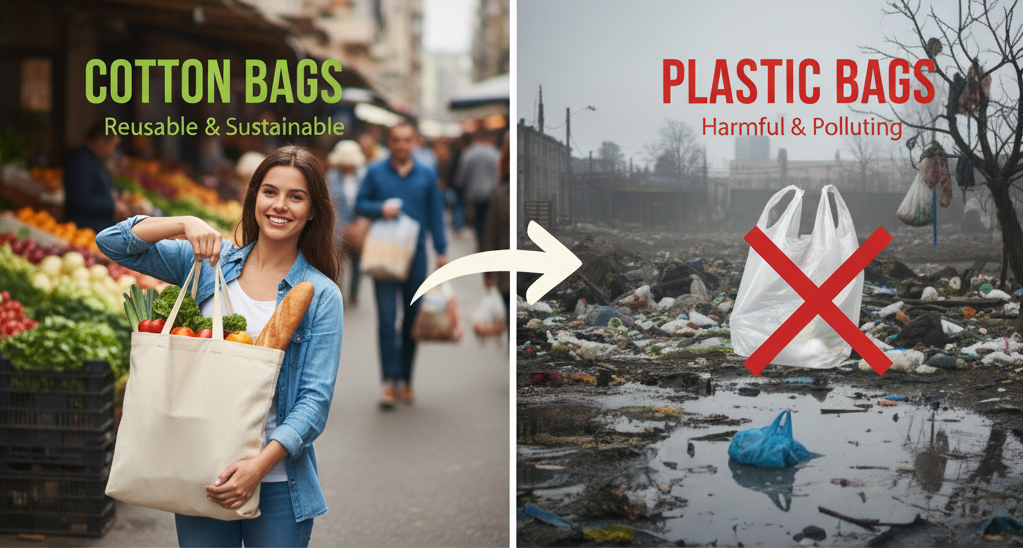
-
24th Sep, 2025
-
(0)

By: Satesh Shaw
Fashion trends change! But what is expected to stay is sustainability. And it is not just with clothes, but also with accessories, like bags. As people are becoming more eco-conscious, they prefer materials that are reusable, sustainable, and stylish. Amongst the many sustainable materials available, jute bags and cotton tote bags are getting more popular.
Both offer durability, eco-friendliness, and versatility, but each comes with its own pros and cons. This blog will walk you through everything you need to know, from material properties to durability, style, cost-effectiveness, and environmental impact, so you can make a more informed choice:
What is a Jute Bag?
Jute bags are versatile, and you can use them for grocery shopping, packaging, and branding because they are sturdy, rustic-looking, and highly sustainable. Jute is a natural fiber extracted from the jute plant. Its golden-brown shine has earned it the “golden fiber”. The fabric is strong, durable, and 100% biodegradable, which makes it one of the most eco-friendly materials used in the bag industry.
How Are Jute Bags Made?
Jute fibers are extracted through retting, dried, and spun into yarn. The yarn is then woven into coarse fabric, cut, stitched, and finished with handles. To make them trendy and fashionable, they are often dyed or laminated.
Key characteristics of jute bags:
- Made from plant-based fibers
- Naturally strong and durable
- Biodegradable and compostable
- Unique rustic and earthy appearance
What is a Canvas Tote Bag?
Canvas is a woven fabric made from cotton or linen. Unlike jute, it has a smooth, soft finish and can be easily dyed or printed with designs. Canvas tote bags are versatile, look chic and trendy, making them popular for everyday use. They are widely used as fashion accessories, promotional giveaways, grocery totes, and travel companions.
How Are Canvas Tote Bags Made?
Canvas bags are woven in a plain weave pattern to create a dense, durable fabric. The fabric is then cut into panels and stitched with reinforced handles. Depending on usage, the fabric may be waxed, dyed, or chemically treated to add water resistance.
Key characteristics of canvas tote bags:
- Made from cotton or linen fibers
- Soft, smooth, and flexible texture
- Easy to customize with prints or embroidery
- Washable and long-lasting
Jute Bag vs Canvas Tote Bag, Which Is the Best?
While both bags are a reasonable option, you also need to consider other factors, for instance:
Durability and Strength
If you are going to use a bag for daily use, the bag needs to be durable and carry heavy things. Jute bags are made of rigid and coarse fibers, which let them withstand heavy loads, making them ideal for groceries, books, and bulk products. However, they are less flexible and not very resistant to water.
Canvas fabric, on the other hand, is much softer but offers the same durability, especially if the bags are made of thick cotton canvas. The fabric is washable and doesn’t lose its shape after washing and repeated use. Canvas tote bags with waterproof coatings or polyester blends are less prone to wear and tear compared to jute when exposed to friction.
So, if you want rigidity for heavy loads, go for jute. If you need long-lasting daily use with flexibility, canvas tote bags are the better choice.
Eco-Friendliness and Sustainability
While both are sustainable, Jute is more eco-friendly than canvas cotton bags. Jute plants absorb large amounts of CO₂ and release oxygen. Moreover, jute grows quickly; it
- requires minimal pesticides,
- is completely biodegradable, and
- has a smaller carbon footprint.
Manufacturing canvas tote bags need significant water and energy resources, making canvas slightly less sustainable in comparison. Organic cotton canvas reduces environmental impact, but if treated with dyes, coatings, or polyester blends, it somewhat loses its biodegradability.
Design and Aesthetics
If you are a fashion-lover but still want to make sustainable decisions, then these bags are perfect. Jute has a natural, rustic, and raw appeal. Printing on jute is possible but limited due to its coarse texture. They are more suitable for brands that want to promote an earthy, eco-conscious identity.
Canvas Tote Bags, on the other hand, give you canvas for creativity. It allows for
- High-quality printing,
- Embroidery, and
- Customization.
Many fashion brands, retailers, and event organizers often prefer canvas totes for promotional campaigns. Brands like Sara International allow customers to customize. We create samples based on your requirements and share it with you before full-scale production.
Cost and Affordability
At the end of the day, the question comes to whether you can afford the bags? And the answer is, YES! Jute Bags are generally cheaper than canvas, especially if you buy in bulk. Since they are made from inexpensive plant fibers, they provide a cost-effective, eco-friendly option.
Canvas tote bags might be slightly more expensive than jute due to higher cotton production costs. However, their durability and reusability may justify the higher investment.
To sum it up
Both Jute bags and canvas tote bags are sustainable options. But there is no one-size-fits-all here. Whether you are using it for personal use or branding is a critical consideration. So, whether you want to go for the first one or the latter completely depends on your budget and personal preference.
Frequently Asked Questions
Q.1. What is the difference between a jute bag and a canvas tote bag?
Jute bags are made from natural jute plant fibers, giving them a rustic look, high strength, and eco-friendliness. Canvas tote bags are made from cotton or linen, offering a softer, smoother texture, better printability, and long-lasting flexibility.
Q.2. Which bag is more eco-friendly: jute or canvas?
Jute bags are generally more sustainable because jute requires minimal water, pesticides, and energy to grow, and it absorbs large amounts of CO₂. Canvas bags, especially if made from organic cotton, are eco-friendly but have a higher environmental footprint compared to jute.
Q.3. Which bag is better for printing and customization?
Canvas tote bags are better for printing, embroidery, and detailed designs because of their smooth surface. Jute bags can also be printed, but the coarse texture limits fine detailing, making them more suitable for bold, rustic designs.
Q.4. Are jute bags cheaper than canvas bags?
Yes. Jute bags are generally less expensive because jute is a low-cost, fast-growing fiber. Canvas tote bags are slightly pricier due to higher cotton production costs, but they are long-lasting, making them a worthwhile investment.
Q.5. Are jute bags and canvas tote bags biodegradable?
Jute bags are 100% biodegradable and compostable. Canvas bags made from pure cotton are also biodegradable, but if treated with synthetic dyes, coatings, or polyester blends, they may lose some biodegradability.
Q.6. Can I wash jute bags and canvas tote bags?
Yes, canvas tote bags are easy to wash and maintain, often even machine-washable. Jute bags should be spot-cleaned or dry-cleaned, as soaking can damage their natural fibers.














Leave a Reply